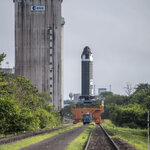Aerospace

The P120C solid-fuel rocket motor that will power Ariane 6 and Vega-C at liftoff has been transferred to the test stand for its first hot firing at Europe’s Spaceport.
P120C will replace P80 as the first stage motor of Vega-C, which is expected to debut in mid-2019 and comprises four stages. Three stages will use solid-propellant motors and one will use liquid propellants. The first stage is the P120C, the largest monolithic carbon fiber solid-propellant rocket motor ever built. Two or four P120Cs will also be strapped onto Ariane 6 as boosters for liftoff.
The second stage of Vega-C…

Science 2.0 began 11 years ago, the year that the James Webb Space Telescope was supposed to be completed, but there was no real cause for alarm about the delays until 2010, when it was three years late and $1.5 billion over budget. Not many in science communication really cared, though that is easy to dismiss as modern journalists being cheerleaders rather than critical thinkers. Instead, the science community has continued to gush how great it will be as JWST missed milestone after milestone after milestone.
Even last month, people were still continuing to write sentences like "JWST…

A new paper believes detection of atmospheric signatures for a few potentially habitable planets could occur before 2030.
Does that mean life on other planets?
Perhaps. perhaps not. We could be first in the universe, even though mathematically we should not be, just like mathematically light from infinite stars could make our sky pure white even at night. But if we are not first, the challenge becomes how to really detect anything else. We are currently unable to visit exoplanets, and since we determined 15 years ago we couldn't even return to the moon until 2020 (and then the succeeding…

What started as a technology development project at NASA’s Jet Propulsion Laboratory (JPL) in August 2013, has become The Mars Helicopter, a small, autonomous rotorcraft which will travel with the agency’s Mars 2020 rover mission, currently scheduled to launch in July 2020 and be the first heavier-than-air craft on another world.
It took four years of design, testing and redesign to get it to under four pounds (1.8 kilograms). Its fuselage is about the size of a softball, and its twin, counter-rotating blades will bite into the thin Martian atmosphere at almost 3,000 rpm – about 10 times…

The James Webb Space Telescope, originally scheduled to be completed in 2007, now might be ready in 2020. If you still believe anything coming from Big Space.
Meanwhile, Big Space claims it is under-funded. While it's true many worthy small experiments can't get the money they need, the reason is not due to the Bush, Obama or Trump administrations, it is because all three of them have watched JWST, the supposed successor to Hubble, bleed funding dry with its constant misses and overruns.
The appeal for science, though the public never had much enthusiasm, is that JWST will be able to…

The Imager for Magnetopause-to-Aurora Global Exploration (IMAGE) project was launched in 2000 to create the first comprehensive images of atmospheric plasma in our magnetosphere, a kind of cosmic demilitarized zone with plasmas of both solar and terrestrial origin. It was still functioning in 2002 when it completed its initial go but then failed to make contact again on a routine pass by the Earth in 2005.
And NASA lost track of it. Like all NASA missions, they can never say failure so even though it only did one thing they declared it worth the $150 million.
But an amateur…

The U.S. National Aeronautics Space Administration NASA has selected two finalist concepts for a robotic mission tentatively set to launch in the mid-2020s.
The two finalists pared down from 12 are Comet Astrobiology Exploration Sample Return (CAESAR), which seeks to bring back a sample from 67P/Churyumov-Gerasimenko, a comet that was successfully explored by the European Space Agency’s Rosetta spacecraft, to determine its origin and history. Led by Steve Squyres of Cornell University in Ithaca, New York, CAESAR would be managed by NASA’s Goddard Space Flight Center in Greenbelt,…

We wingless humans have somehow come to take flying for granted.
To help us renew our appreciation of the miracle of flight, we thought it might be worth our time to explore the science behind the engineering that gets our planes in the air — and our bodies from one coast, or one continent, to another. Plus, if you’ve ever wanted to pursue an aircraft engineering career, we’ve got the scoop on how to make that happen.
The Science Behind Aircraft Design
To understand the science behind an aircraft’s ability to sustain flight — and the aircraft engineering that takes advantage of that science…

Anyone announcing the successful sale of tourist trips around the moon would attract ridicule and laughter. Unless your name is Elon Musk. In that case the announcement amounts to nothing more than a logical and rather modest step towards Musk's promise of getting a million people to live on Mars.
One might question why humanity would be interested to colonize an inhospitable planet. Sure, rising CO2 levels in Earth's atmosphere do pose a challenge, and this issue might make few of us long for a second planet. But when given a choice between a planet with a CO2 level a notch above 0.04…

ESA’s Rosetta mission has concluded as planned, with the controlled impact onto the small lobe of Comet 67P/Churyumov–Gerasimenko, close to a region of active pits in the Ma’at region, which it had been investigating for more than two years.
Confirmation of the end of the mission arrived at ESA’s control centre in Darmstadt, Germany at 11:19 GMT (13:19 CEST) with the loss of Rosetta’s signal upon impact, but the descent gave Rosetta the opportunity to study the comet’s gas, dust and plasma environment very close to its surface, as well as take very high-resolution images. …